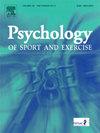Auditory cues in table tennis: Evaluating their effectiveness compared to visual information
IF 3.3
2区 心理学
Q2 HOSPITALITY, LEISURE, SPORT & TOURISM
引用次数: 0
Abstract
In table tennis, the sounds of ball-racket impacts provide meaningful cues for identifying the rotational features of the ball, but the contribution of environmental auditory information to table tennis striking performance is still unclear. This exploratory study investigated the role of auditory information as cues for table tennis striking. Eleven elite varsity table tennis players performed forehand push and topspin-drive strokes to return oncoming balls under three information conditions: normal, visual-only with earmuffs and white noise, and auditory-only with goggles occluding vision. The time intervals between impact sounds were analyzed between the two types of oncoming balls. The percentage of successful trials, the in-bounds rate, the kinematics performance of the racket and the ball and movement time lags were analyzed between conditions for push and topspin-drive strokes, respectively. The participants could pick up the distinguishable cues through auditory perception, enabling them to perform push and topspin-drive techniques correctly in the auditory-only condition. However, participants initiated movements later, reduced movement times and distances, and exhibited higher variability of movement time lags when only relying on auditory information. Deprivation of auditory information affected the speed of the racket and the ball at the termination of movement. The elite players could identify the spatial outcome of the oncoming ball by detecting auditory cues. Eliminating their auditory information affected their perception-action coupling, although this information did not play a dominant role in striking.
乒乓球运动中的听觉线索:与视觉信息相比评估其有效性。
在乒乓球运动中,球拍撞击的声音为识别球的旋转特征提供了有意义的线索,但环境听觉信息对乒乓球击球表现的贡献尚不清楚。本研究探讨了听觉信息在乒乓球击球中的提示作用。11名优秀的乒乓球运动员在三种信息条件下进行正手推球和上旋球回击,这三种信息条件分别是:正常、戴耳罩和白噪音的纯视觉和戴眼镜遮挡视觉的纯听觉。分析了两种迎面而来的球撞击声的时间间隔。分析了推球和上旋球两种击球方式的试球成功率、出界率、球拍和球的运动性能以及运动滞后时间。被试可以通过听觉感知获得可区分的线索,使他们能够在听觉条件下正确地执行推和上旋驱动技术。然而,当只依赖听觉信息时,参与者开始运动的时间更晚,运动时间和距离更短,并且表现出更高的运动时间滞后变异性。听觉信息的剥夺影响了球拍和球在运动结束时的速度。优秀球员可以通过听觉线索识别迎面球的空间结果。消除他们的听觉信息会影响他们的感知-行动耦合,尽管这种信息在打击中并不起主导作用。
本文章由计算机程序翻译,如有差异,请以英文原文为准。
求助全文
约1分钟内获得全文
求助全文
来源期刊
CiteScore
6.40
自引率
5.90%
发文量
172
审稿时长
69 days
期刊介绍:
Psychology of Sport and Exercise is an international forum for scholarly reports in the psychology of sport and exercise, broadly defined. The journal is open to the use of diverse methodological approaches. Manuscripts that will be considered for publication will present results from high quality empirical research, systematic reviews, meta-analyses, commentaries concerning already published PSE papers or topics of general interest for PSE readers, protocol papers for trials, and reports of professional practice (which will need to demonstrate academic rigour and go beyond mere description). The CONSORT guidelines consort-statement need to be followed for protocol papers for trials; authors should present a flow diagramme and attach with their cover letter the CONSORT checklist. For meta-analysis, the PRISMA prisma-statement guidelines should be followed; authors should present a flow diagramme and attach with their cover letter the PRISMA checklist. For systematic reviews it is recommended that the PRISMA guidelines are followed, although it is not compulsory. Authors interested in submitting replications of published studies need to contact the Editors-in-Chief before they start their replication. We are not interested in manuscripts that aim to test the psychometric properties of an existing scale from English to another language, unless new validation methods are used which address previously unanswered research questions.

 求助内容:
求助内容: 应助结果提醒方式:
应助结果提醒方式:


